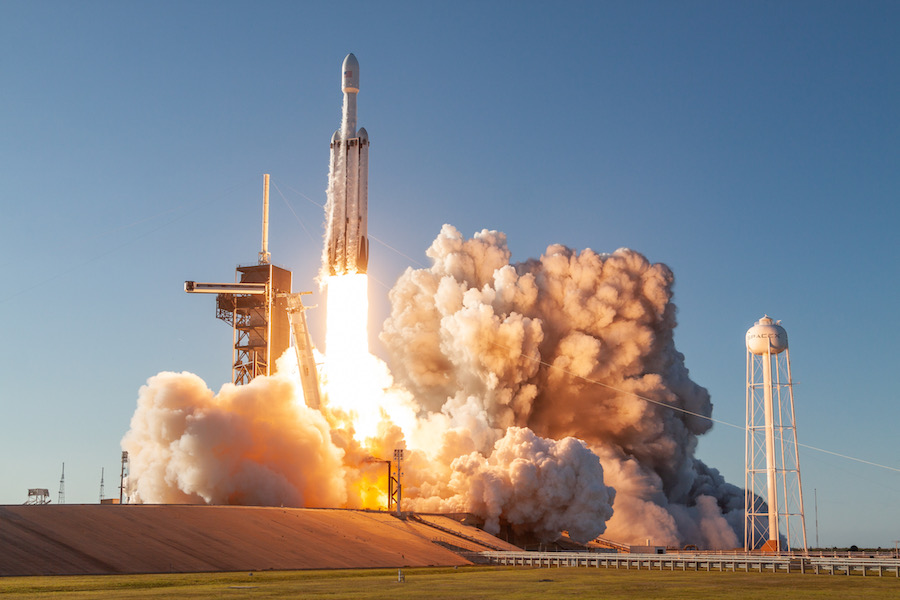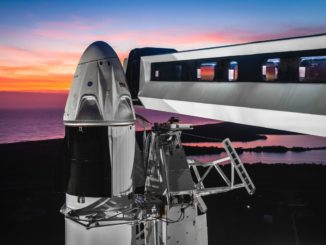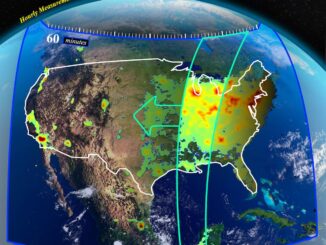
The core booster from the Falcon Heavy rocket that launched Thursday from NASA’s Kennedy Space Center in Florida tipped over in rough seas after landing on an offshore drone ship, SpaceX officials said Monday.
The Falcon Heavy’s core booster touched down around 10 minutes after the Falcon Heavy blasted off from Florida’s Space Coast, and moments after the rocket’s two side boosters returned to landing onshore at Cape Canaveral Air Force Station.
The on-target landings marked the first time SpaceX landed all three Falcon Heavy boosters on the same mission. The core stage crashed at sea near the drone ship after running out of igniter fluid on the Falcon Heavy’s inaugural flight in February 2018.
But ocean swells rocking the drone ship, which SpaceX has named “Of Course I Still Love You,” caused the rocket to topple before recovery crews could secure the booster to the vessel.
“Over the weekend, due to rough sea conditions, SpaceX’s recovery team was unable to secure the center core booster for its return trip to Port Canaveral,” said James Gleeson, a SpaceX spokesperson. “As conditions worsened with eight to ten foot swells, the booster began to shift and ultimately was unable to remain upright.
“While we had hoped to bring the booster back intact, the safety of our team always takes precedence,” Gleeson said in a statement. “We do not expect future missions to be impacted.”
The launch was successful in its primary objective, and delivered the Arabsat 6A communications to orbit to begin a mission beaming video, radio and Internet signals across the Middle East, North Africa and Europe.
The Falcon Heavy side boosters and the two halves of the rocket’s payload shroud were recovered intact and will be reused on future missions, SpaceX said.
The system SpaceX typically employs to secure the booster to the drone ship was not able to be used on the Falcon Heavy mission because the core booster uses a different mechanical interface. But SpaceX intends to use the system on the next landing attempt.

Lifting off with more than 5.1 million pounds of thrust, the Falcon Heavy arced toward the east from the Kennedy Space Center powered by 27 Merlin main engines — nine on each of the rocket’s three first stage boosters.
The Falcon Heavy’s core booster fired for three-and-a-half minutes on Thursday’s launch, accelerating to a speed of more than 6,600 mph (10,700 kilometers per hour) before detaching and giving way to the rocket’s upper stage to finish the task of placing the Arabsat 6A communications satellite into orbit.
The twin side boosters jettisoned a minute earlier — at about T+plus 2 minutes, 30 seconds — to begin their journeys back to Cape Canaveral. The core stage flew at a lower throttle setting to conserve fuel, then ramped up to full power after the side boosters separated.
SpaceX’s drone ship was parked around 615 miles (990 kilometers) east of Cape Canaveral for Thursday’s mission, farther downrange than the vessel’s typical position for a SpaceX launch, due to the high-speed staging on the Falcon Heavy.
The side boosters that landed after Thursday’s launch will be inspected and refurbished for the next Falcon Heavy flight scheduled for late June, which was already planned to use a new core booster. The two-piece payload shroud will be reused on a Falcon 9 launch later this year carrying a batch of SpaceX’s Starlink broadband Internet satellites into orbit.
With the Falcon Heavy’s core stage lost after landing, the tally of rocket boosters successfully recovered by SpaceX now stands at 37 vehicles — 23 on drone ships, 13 at Cape Canaveral Air Force Station, and one at Vandenberg Air Force Base, California.
Email the author.
Follow Stephen Clark on Twitter: @StephenClark1.



